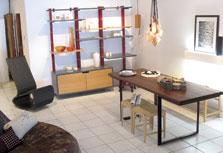
HOT & COLD. Two of Moore's designs, on display in MADE's showroom, illustrate his quest for balance between warmth and elegance: a table of dark walnut paired with raw steel and a shelving unit contrasting Douglas fir with cool grey and bright red.
When asked to name his most prized home furnishing, designer and MADE Design coowner Shaun Moore’s eyes light up. “Well, I bought the peeing boy,” he says, smiling.
The peeing boy is actually called “Accident” and it’s an 11-inch-tall porcelain figurine of a small boy hanging his head, ashamed at a stream of gold lustre spilling from his crotch down his leg.
The piece, created by Vancouver-born artist Jeremy Hatch, was included in Radiant Dark, a design exhibit curated by MADE that coincided with the International Design Show in February. It’s both darkly humourous and point perfect in its craftsmanship — two attributes guaranteed
to attract Moore’s attention.
“I tend to be drawn to things that have a dark spirit to them,” says Moore, sitting inside MADE’s Dundas St W showroom. “That piece is fantastic — it shows an unusual way of thinking. It’s a little bit warped yet it’s presented in a way that’s kind of traditional.”
MADE is located on a strip of Dundas West that is largely untouched by gentrification; the shop could easily be missed by casual passersby. Its logo is affixed overtop a sign for the Chinese herbal shop that previously occupied the space. Because their store is a maze of unusual, self-conscious and generally pricey home furnishings, Moore and his business partner Julie Nicholson kept the original sign out of respect for the neighbouring Portuguese eateries and Chinese businesses. It’s the kind of quiet and thoughtful detail that is in tune with Moore’s own work and curatorial outlook.
“We didn’t want to be that shiny modern store that shoves itself into the middle of everything,” says Moore. “We wanted to make our mark but in a way that’s also comfortable for the people that have worked here their whole lives.”
Over the past three years the store has become well known in the interior design community as the go-to for conceptual and unique Canadian design.
MADE was born in 2006 of Moore and Nicholson’s mutual dissatisfaction with the lack of outlets for independent Canadian designers working on a small scale and from a more artistic-minded viewpoint. “I’m allowed to complain about things but only so much before I take action,” he says. “Being dissatisfied without attempting to make that change is pointless.”
Moore, who graduated from Sheridan College’s furniture design program in 2001, is originally from Winnipeg, a city
the 35-year-old calls “the world capital of nondesign.” Growing up in suburban Southdale did not instill an appreciation
for fine things. Instead he threw his energy into training as a decathlete from junior high through to university.
He attended the University of Manitoba on an athletic scholarship, earning a place on the Canadian junior track team and winning a silver medal. But Moore sustained a knee injury and was forced to quit the sport in 1993. His best event was the 110-metre hurtle and he’s pretty sure he still holds an obscure record in the heptathlon — a rarely competed indoor version of the sport.
“It was a salvation,” he remembers. “I loved it and I tend to go intense with the things that I love. At my peak I was training 35 hours a week — it was like a full-time job. I was totally lost for a little while without it. Every goal, everything I was working for was gone.”
Without the decathlon he no longer felt tied to Winnipeg, so he opted to take advantage of his Irish heritage, applied for an Irish passport and moved with his partner Todd to Dublin for two and a half years to work for the mid-range European furniture retailer Habitat. That job eventually led him to back to Canada, where he pursued furniture design at Sheridan.
Moore says he isn’t nostalgic and rarely talks about that time in his life. “There were good things about that time but it’s not where I am now, it’s not the people I’m around now, it’s not the goals I have now,” he says. “I prefer to focus on where I’m trying to go and who the people are that matter a lot to me at this point in life.”
Though she knew him a few years before learning of his athletic past, business partner Nicholson says she wasn’t surprised. The energy and drive he brings to MADE generally results in 70-hour work weeks — double the time he spent training.
They met in 2001 and launched the company as a design retail/consultancy at the Gladstone Hotel’s alternative design event, Come Up to My Room, in 2006. “It was the idea that something could be both modern and intrinsically warm. There’s a durability and a character to that kind of a feeling — that’ something that interested us both,” she says of their decision to into business together.
In addition to representing a roster of 50 to 60 Canadian designers they also collaborate, most notably on a line of milk crate benches and stools, and curate the annual Radiant Dark exhibit, a sister event to Come Up to My Room that strays away from the store’s functional mandate into more conceptual art territory.
This year’s Radiant Dark — called Elegant Corruptions — was intended to nudge MADE toward a more subtlety refined aesthetic.
“People look in here and think things are clever or humourous but being on trend is not the desired end result,” says Nicholson. “It is about elegance because that’s got staying power.”
Since MADE started Moore hasn’t had time to devote to his own design practice, which explores material contrasts through colour. A formal dining table on display at MADE is a typical example. The dark walnut top is paired with a raw steel structure with a deep plum finish. At the back of the shop a shelving unit deftly balances cool grey and warm Douglas fir shelves on beams of bright red steel.
“I’ve always liked to play with the idea of temperature in colour and tone,” he says. “A lot of furniture and design that’s out there is not very interested in colour, there’s the conservativism of trying to keep things very level with beiges, chocolates, cream colours and stainless steel.”
That contrast between elegant and unusual is something he tries to achieve in his Cabbagetown home. Though he hasn’t found a place for his “peeing boy” figurine yet, it will likely add a tragically comic touch to a space filled with warmth and elegance.
“Sometimes it’s just about the balance created in a space,” he says. “A quirk, something that makes you smile or that feels a little bit edgy or strange or unusual.”

 Why you can trust Xtra
Why you can trust Xtra


